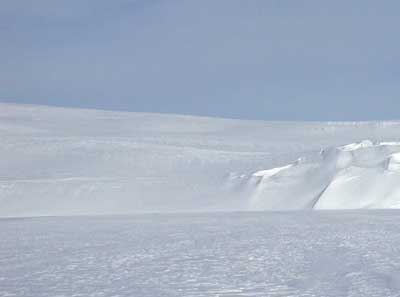Some scientists believe that this has already happened
Avi Blizovsky

Direct link to this page: https://www.hayadan.org.il/coldearth0305.html
Scientists are now certain that the Earth went through a serious ice age 600-800 million years ago, when the entire planet was covered in snow and ice. A new theory that attempts to explain the extreme cooling is that the solar system probably passed through an interstellar cloud of dust and gas, which hid the sunlight. Even if the cloud wasn't so dense as to hide all sunlight, it might allow charged particles to cross Earth's atmosphere and destroy the ozone layer. These clouds are enormous in size and it may take the sun half a million years to pass through such a cloud. This is according to two studies recently published with the support of NASA's Astrobiology Institute.
One of the studies highlighted a scenario in which the Earth froze during the snowball process, after the solar system passed through a compressed cosmic cloud. According to the second study's more likely scenario, smaller molecular clouds might allow charged particles to penetrate through the atmosphere, destroying the protective ozone layer, resulting in a mass extinction. Both studies were published in Geophysical Research Letters.
"Computer models show that dramatic changes can be caused by the accumulation of interstellar dust in the Earth's atmosphere during a transit period of the Sun in a dense space cloud," said Alex Perlov, the lead researcher on both papers and a scientist at the University of Colorado at Boulder. The result is that dust floats in the atmosphere and may absorb scattered solar radiation, allowing heat to escape into space while causing accelerated cooling through ice build-up and glacier formation.
There is evidence that in the period 600-800 million years before our time there were at least four global ice ages. The mystery is around the question of what was the switch that caused this." Perlov said. "He concludes that the glaciers covered the entire earth. His work is supported by NASA's Astrobiology Institute, which has offices at NASA's Ames Research Center in Silicon Valley.
Pavlov said that his hypothesis still needs to be tested by geologists. They need to look for rocks from the relevant layers and associate them with the giant glaciers in order to assess whether there was a relatively high presence of uranium 235. This isotope cannot be formed on Earth or in the solar system, but is formed in space clouds due to stellar explosions known as supernovae.
Small changes in the ratio between uranium 235 and 238 in rock layers may be the proof that it is a material originating from supernovae.
Collisions of the Solar System with dense clouds are rare, but according to Pavlov's team, they are rarer, but collisions with less dense clouds may have been more common. He highlighted a series of events that resulted in the loss of most of the ozone layer, if the solar system collided with a medium-density cloud.
However, due to a large influx of particles from the interstellar cloud into the Sun's heliosphere, the Sun increases the production of electrically charged cosmic rays from the hydrogen particles. This also increases the flow of cosmic rays towards the earth. Normally, the magnetic field and ozone protect life from dangerous ultraviolet radiation from cosmic rays and the sun.
Compressed space clouds are huge and the solar system may take half a million years to cross them. Once you enter such a cloud, the Earth is expected to undergo at least one magnetic reversal. During reversal, charged cosmic particles may enter Earth's atmosphere instead of being repelled by Earth's magnetic field.
Cosmic rays can penetrate through the atmosphere and break the oxygen molecules to form nitrogen monoxide. This gas serves as a catalyst for a series of acts of destruction such as 40 percent of the protective ozone layer in the upper atmosphere all over the world and to destroy about 80 percent of the ozone in the polar regions. says Pavlov.
Original Source: NASA News Release
For news in Winevers Today
For information on the NASA website
Earth scientist - planet
https://www.hayadan.org.il/BuildaGate4/general2/data_card.php?Cat=~~~103071565~~~138&SiteName=hayadan
